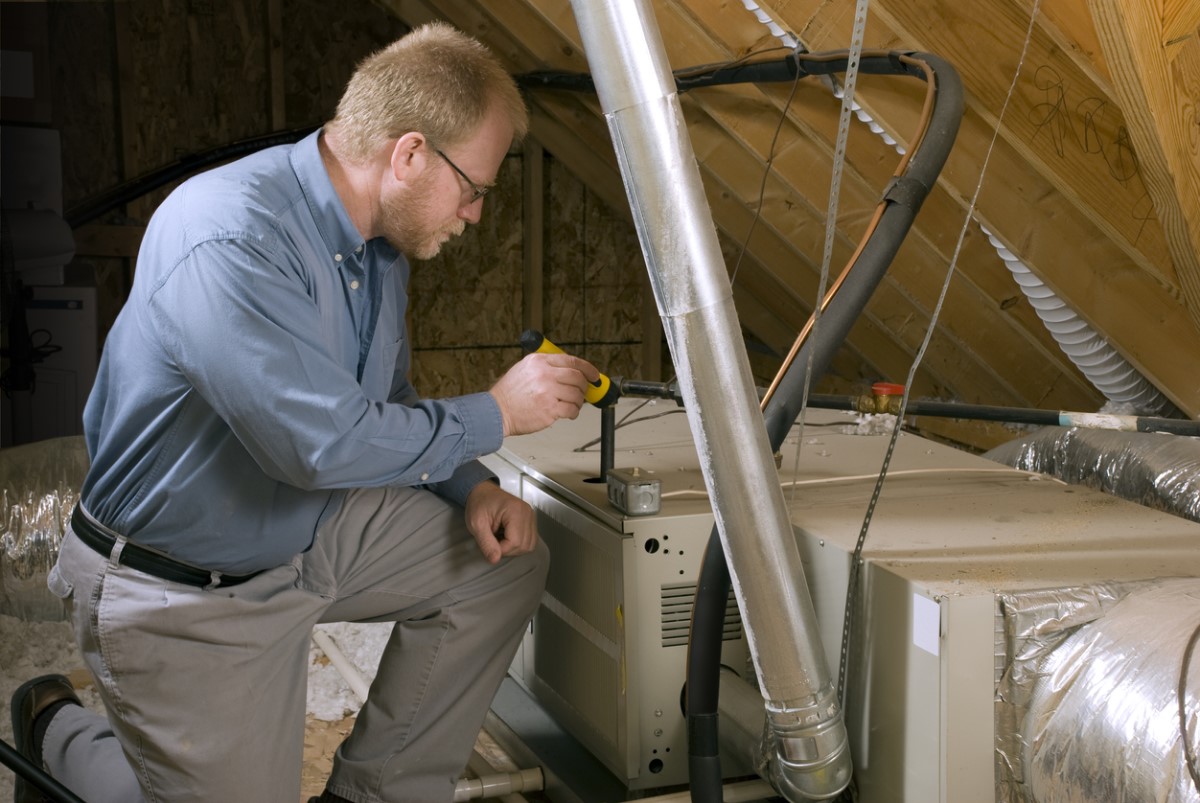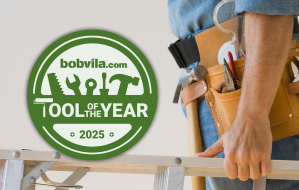

We may earn revenue from the products available on this page and participate in affiliate programs. Learn More ›
Now that winter’s nearly here, it’s time for a pop quiz: You wake up in the morning and there’s ice on the dog’s water dish. What do you do?
If you had trouble with that one, it’s time for a quick lesson on furnace troubleshooting. Here are nine easy tasks you can perform yourself to try and get your gas furnace—the nation’s most popular type—kicking out heat again.
STEP 1: Make sure the thermostat is set to “Heat.”
“This sounds obvious, but it’s true: A lot of people don’t have their thermostat set right,” says Bobby Difulgentiz, director of product management for Lennox International. So the first step in troubleshooting your furnace is to double-check that the thermostat is set correctly. “Many thermostats have to be physically set to “Heat,” Difulgentiz says. That switch can easily get moved—say, during dusting. He also advises making sure the set point is at a temperature that will actually turn on the furnace.
Give the furnace a minute or so for the fan and the heat to kick on. If the furnace is still not turning on, set the thermostat to 90 degrees Fahrenheit. That way it won’t turn on and off repeatedly while you’re troubleshooting.

STEP 2: Assess if it’s time to change your furnace filter.
Filter-related failures are probably one of the most common furnace problems out there, primarily because homeowners forget about the filters, says Difulgentiz.
Filters clean the air headed into the furnace and the heated air sent back into the house. A dirty, clogged filter limits the airflow, eventually causing heat and pressure to build up in the furnace. Newer, more efficient furnaces are sensitive to the problem and will often shut down before a dirty filter causes more trouble. For other units, the furnace will continue to run but with less heat output and reduced efficiency, he says.
How do you know if this is your furnace’s problem? First, check your filter for obvious dirt. Don’t try to skimp by cleaning and reusing cheap hardware-store filters, says Mike Bonner, a heating and cooling technician and instructor with 35 years of experience who now offers helpful advice at Gray Furnace Man. They have been sprayed with an oil that catches dirt, and once saturated they are no longer effective. “I recommend that homeowners replace their filters once a month,” Bonner says. “A monthly routine will be much easier to remember than every two months—and it’s that important.”
Another way to determine that you may have a filter failure: Listen for a whistle. If the furnace can’t get enough air through the filter, it pulls air through any opening it can. A whistling sound is an indication of a problem.
STEP 3: Check the battery.
Some thermostats are wired to the house’s electrical system, while others use batteries. How is yours powered? Sometimes those that use batteries will flash a low-battery symbol when they need a replacement, but the signal often goes unnoticed, says Bonner.
STEP 4: Confirm that your furnace is getting power.
You need to know if the furnace is getting electricity, so check. Most thermostats have a switch for the fan that says either “On” or “Auto” (which means that the fan turns on when the equipment comes on). Throw the switch to “On.” “If the fan comes on, then you know you’ve got power to the furnace. If it doesn’t, you know you’ve got other problems,” Bonner says.

STEP 5: If the machine doesn’t power on, check the circuit breaker.
Still haven’t found the problem? Here’s the next step in furnace troubleshooting: Go to your home’s breaker panel and look for the circuit that controls the furnace. You’re looking to see whether it’s thrown to the “Off” position, or whether it’s in the middle because your circuit breaker was tripped. (In some panels the switch shows red.)
Some electricians do a poor job of labeling—or correctly labeling—appliances in the house. Don’t see the furnace listed? “You’re looking for the one switch that seems in a different position from all the others,” Bonner says. “To fix it, throw it all the way off, then back on.”
STEP 6: Throw another switch, this one located near the furnace.
Furnaces have another switch, simply known as the “furnace switch.” It’s a power switch that often looks like a regular light switch. It can be located either on the unit or—because electricians often work before the furnace is installed—on a wall nearby. Often this switch is unlabeled. If installed correctly, the switch in the up position is “On.” Unfortunately, this switch can sometimes be mistaken for a light switch and accidentally turned off. Throw this switch and give it a few minutes, as some furnaces have a few minutes’ delay.
RELATED: Solved! How Long Does A Furnace Last?
STEP 7: Look for a code that indicates the problem.
Furnaces built about 1990 or later have a tiny window where a light shows through. That light can not only tell you whether the furnace has power, but it can also flash a code to help you know what’s going on.
If you’ve flipped the furnace switch off, then back on, note the sequence of the flashing light. Then open the furnace’s access panels (there are usually two). Inside one will be a key that tells you what the code means. That meaning will be useful information to tell a technician if the furnace still won’t start after you replace the panels.
STEP 8: On an older model, you may need to relight the furnace’s pilot light.
“If your furnace has a pilot light—anything less than 20 years old won’t—there are instructions in your owner’s manual for how to relight the pilot,” says Bonner. A modestly capable homeowner should be able to do it. You’re dealing with fire, however, so don’t do anything you’re not comfortable with.
STEP 9: If all else fails, check the gas valve.
If all else fails, check the furnace’s gas valve to make sure that it hasn’t somehow been turned to the “Off ” position. Any gas furnace has a “gas cock” that has to be located within six feet of the furnace, Bonner says. This is usually never touched, but you could check it. Another way to double-check: If you have more than one gas appliance, find out if it’s working. If it is, you know that the gas line into the home is OK.
Prevent trouble with a periodic HVAC inspection.
So when should you give up troubleshooting your furnace yourself and call in the cavalry? That point varies for every homeowner. “When you get uncomfortable, call somebody,” Bonner says.
An ounce of prevention is worth a pound of cure: Lennox’s Difulgentiz recommends that someone come out twice a year—in spring to check on the air conditioner before it gets a workout, and in autumn to make sure the furnace is running efficiently: “Typically it’s not that expensive,” he says of such maintenance visits. “It’s a good thing to do, with such a high-dollar item in your house.” For about $100 or so, a technician will eyeball the system, oil the motors, run a safety check, and clean the flame rod on the newer furnaces to make sure the flame is there.
Adds Bonner: “If your furnace is located in a laundry room, I would definitely service it every year, because we have chlorine and phosphates and all sorts of odd chemicals in the laundry room. They get into the flame and the flame chemically changes them” and the resulting chemicals can damage the guts of the furnace, like the heat exchanger, he says. Also, there’s substantial lint in a laundry room. If a heat exchanger breaks, carbon monoxide could leak into a home, Bonner points out.
